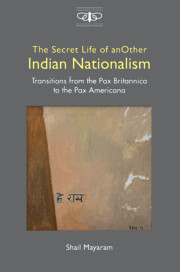 The Secret Life of AnOther Indian Nationalism
The Secret Life of AnOther Indian Nationalism Book contents
- Frontmatter
- Dedication
- Contents
- List of Figures
- List of Abbreviations
- Preface
- Acknowledgements
- Note on Transliteration
- 1 Introduction: Colonialism, Orientalism, Nationalism and the Shaping of Popular History and Religion
- 2 Orienting the Vernacular Imaginaire: James Tod and Indian Nationalism
- 3 War and Violence in Savarkar’s View of Indian History
- 4 Nationalism and Time: The Vishva Hindu Parishad’s Fantasmagorical History
- 5 Transforming Hinduism: The Politics of Vishva Hindu Parishad Conversion
- 6 AnOther History of Religion
- 7 Sushila Rawat, the Healer of Husain Tekri: Myth and Medical Pluralism as Resistance to Hindutva
- Index
3 - War and Violence in Savarkar’s View of Indian History
Published online by Cambridge University Press: 11 February 2022
- Frontmatter
- Dedication
- Contents
- List of Figures
- List of Abbreviations
- Preface
- Acknowledgements
- Note on Transliteration
- 1 Introduction: Colonialism, Orientalism, Nationalism and the Shaping of Popular History and Religion
- 2 Orienting the Vernacular Imaginaire: James Tod and Indian Nationalism
- 3 War and Violence in Savarkar’s View of Indian History
- 4 Nationalism and Time: The Vishva Hindu Parishad’s Fantasmagorical History
- 5 Transforming Hinduism: The Politics of Vishva Hindu Parishad Conversion
- 6 AnOther History of Religion
- 7 Sushila Rawat, the Healer of Husain Tekri: Myth and Medical Pluralism as Resistance to Hindutva
- Index
Summary
On 30 January 1948, Gandhi died, falling to gun shots fired by Nathuram Godse (1910–49). This was the confrontation of two different ideologies of nationalism, two competing values of loyalty to truth and to the nation, and of two contrary emotions, namely love and anger. Gandhi believed in non-violence and was prepared to extend forgiveness to his interlocutors and even potential assassins. Savarkar, the mentor of the assassins thought non-violence was sinful and stood for violence against the enemy and an idea of national belonging that included only those whose sacred sites were in the subcontinent, thereby excluding Muslims and Christians.
James Douglass’ wonderful book, Gandhi and the Unspeakable: His Final Experiment with Truth sees Gandhi as a ‘martyr to the unspeakable’. The idea of the Unspeakable comes from Thomas Merton and refers to the void that enters public and official pronouncements that makes them ‘ring dead with the hollowness of the abyss’. Douglass sees in the systemic evil of murders not only the deceit and denial of the state, but also the possibility of confronting evil courageously, unveiling the face of the truth. Gandhi had foreseen his violent death, prepared for it for half a century, and was ready to meet his assassin with love—this was the key to his encounter with the Unspeakable. He had ‘trained himself, step by step, to die nonviolently to violence. It would be his final experiment with truth…. Walking with Gandhi means walking joyfully and nonviolently into God's arms—the arms of truth and love— through death. That is a way of hope,’ writes this Catholic theologian and activist for non-violence.
Douglass writes forcefully of Savarkar and Gandhi's ‘developing visions of violence and nonviolence, terrorism and satyagraha (truth-force), assassination and martyrdom, [that] competed then—and compete now with greater urgency— for the future of India and the world’. The two conflicting philosophies facing humankind today that Narayan Desai refers to in his blurb to Douglass’ book are really two versions of nationalism, one of them being an extreme nationalism that inspired Gandhi's assassination.
At the trial the defendants tried to murder Gandhi all over again, Douglass points out, decrying his person and vision.
- Type
- Chapter
- Information
- The Secret Life of AnOther Indian NationalismTransitions from the Pax Britannica to the Pax Americana, pp. 86 - 120Publisher: Cambridge University PressPrint publication year: 2022


